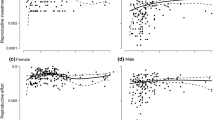Summary
Optimal allocation of energy to growth, reproduction and storage was considered for perennial plants differing in the proportion of vegetative structures persisting over winter and/or in the amount of resources which can be relocated to storage before abscission of some organs. It was found that for every mortality level there exists a critical proportion of persistent organs. Below this critical value it is optimal to grow without reproduction for the first years until a characteristic size is reached; afterwards, that size is maintained year after year and all extra resources are devoted to reproduction. Some storage is also necessary to maintain constant size. If the proportion of retained vegetative mass is above the critical value, the optimal strategy is gradual growth to an asymptotic size, with growth and reproduction occurring in several years following maturation. In this case real storage occurs only until maturation is reached, then storage is realized only by energy relocation from the vegetative body. Although the optimal solution changes abruptly qualitatively at a given proportion of resources saved from year to year, further growth of this proportion above the critical level brings about a greater difference between size reached at maturity and final size. The predictions of the model seem to follow the pattern of nature qualitatively.
Similar content being viewed by others
References
Berkovitz, L. D. (1974)Optimal control theory. Springer Verlag, New York.
Cohen, D. (1971) Maximizing final yield when growth is limited by time or by limiting resources.J. Theor. Biol. 33, 299–307.
Dechert, W. D. and Nishimura, K. (1983) A complete characterization of optimal growth paths in an aggregated model with a non-concave production function.J. Econ. Theory 31, 332–54.
Harper, J. (1977)Population Biology of Plants. Academic Press, London.
Harper, J. and White, J. (1974) The demography of plants.Ann. Rev. Ecol. Syst. 5, 419–63.
Hom, C. L. (1987) Control theory predictions of reproductive allocation in female dusky salamanders.J. Math. Biol. 25, 289–306.
Inghe, O. and Tamm, C. O. (1985) Survival and flowering of perennial herbs. IV. The behaviour ofHepatica nobilis andSanicula europaea on permanent plots during 1943–1981.Oikos 45, 400–20.
Inghe, O. and Tamm, C. O. (1988) Survival and flowering of perennial herbs. V. Patterns of flowering.Oikos 51, 203–19.
Iwasa, Y. and Cohen, D. (1989) Optimal growth schedule of a perennial plant.Amer. Natur. 133, 480–505.
Iwasa, Y. and Roughgarden, J. (1984) Shoot/root balance of plants: optimal growth of a system with many vegetative organs.Theor. Pop. Biol. 25, 78–105.
King, D. and Roughgarden, J. (1982a) Multiple switches between vegetative and reproductive growth in annual plants.Theor. Pop. Biol. 21, 194–204.
King, D. and Roughgarden, J. (1982b) Graded allocation between vegetative and reproductive growth for annual plants in growing seasons of random length.Theor. Pop. Biol. 22, 1–16.
King, D. and Roughgarden, J. (1983) Energy allocation patterns of the California grassland annuals,Plantago erecta andClarkia rubicunda.Ecology 64, 16–24.
Kozlowski, J. and Wiegert, R. G. (1986) Optimal allocation of energy to growth and reproduction.Theor. Pop. Biol. 29, 16–37.
Kozlowski, J. and Wiegert, R. G. (1987) Optimal age and size at maturity in annuals and perennials with determinate growth.Evol. Ecol. 1, 231–44.
Kozlowski, J. and Uchmanski, J. (1987) Optimal individual growth and reproduction in perennial species with indeterminate growth.Evol. Ecol. 1, 214–30.
Kozlowski, J. and Ziolko, M. (1988) Gradual transition from vegetative to reproductive growth is optimal when the maximum rate of reproductive growth is limited.Theor. Pop. Biol. 34, 118–29.
McKenzie, L. W. (1986) Optimal economic growth, turnpike theorems and comparative dynamics. InHandbook of Mathematical Economics, Vol. III (K. J. Arrow and M. D. Intrilligator, eds) Elsevier, pp. 1281–355.
Press, W. H., Flannery, B. P., Teukolsky, S. A. and Vetterling, W. T. (1986)Numerical recipes. Cambridge University Press, Cambridge.
Pugliese, A. (1987) Optimal resource allocation and optimal size in perennial herbs.J. Theor. Biol. 126, 33–49.
Pugliese A. (1988b) Optimal life history models: effects of nonlinearities in the response of reproductive success to investment. InBiomathematics and related computational problems (L. M. Ricciardi, ed.) Klawen Academic Press, Dordrecht, pp. 223–35.
Pugliese, A. and Armstrong, R. A. (1989) Reproduction and growth in the perennial herbSmilacina racemosa: comparison with a life history model. Manuscript.
Ross, S. M. (1983)Introduction to stochastic dynamic programming. Academic Press, New York.
Schaffer, W. M. and Rosenzweig, M. L. (1977) Selection for optimal life histories. II: Multiple equilibria and the evolution of alternative reproductive strategies.Ecology 58, 60–72.
Schaffer, W. M., Inouye, R. S. and Whittam, T. S. (1982) Energy allocation by an annual plant when the effects of seasonality on growth and reproduction are decoupled.Amer. Natur. 120, 787–815.
Sibly, R. and Calow, P. (1986)Physiological ecology of animals: an evolutionary approach. Blackwell, Oxford.
Spence, M. (1973)Blue whales and applied control theory. Technical Report No. 108, Stanford University, Institute for Mathematical Studies in the Social Sciences.
Vincent, T. L. and Pulliam, H. R. (1980) Evolution of life history strategies for an annual plant model.Theor. Pop. Biol. 17, 215–31.
Ziolko, M. and Kozlowski, J. (1983) Evolution of body size: an optimization model.Math. Biosci. 64, 127–43.
Author information
Authors and Affiliations
Rights and permissions
About this article
Cite this article
Pugliese, A., Kozlowski, J. Optimal patterns of growth and reproduction for perennial plants with persisting or not persisting vegetative parts. Evol Ecol 4, 75–89 (1990). https://doi.org/10.1007/BF02270717
Issue Date:
DOI: https://doi.org/10.1007/BF02270717




